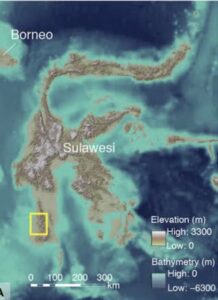In news- Researchers have reported that Pleistocene-era rock paintings dating back to 45,000-20,000 years ago in cave sites in southern Sulawesi, on the Indonesian island of Sulawesi, are weathering at an alarming rate.
More about the caves-
- The area is known to be home to over 300 cave paintings, and more are being discovered with further explorations.
- A team of Australian and Indonesian archaeological scientists, conservation specialists, and heritage managers examined 11 caves and rock-shelters in the Maros-Pangkep region in Sulawesi.
- The artwork in the area includes the world’s oldest hand stencil (almost 40,000 years ago), created by pressing the hand on a cave wall, and spraying wet red-mulberry pigments over it.
- A nearby cave features the world’s oldest depiction of an animal, a warty pig painted on the wall 45,500 years ago.
- The cave art of Sulawesi is much older than the prehistoric cave art of Europe.

Findings of the study-
- The researchers studied flakes of rock that have begun to detach from cave surfaces to find that salts in three of the samples comprise calcium sulphate and sodium chloride, which are known to form crystals on rock surfaces, causing them to break.
- The artwork made with pigments was decaying due to a process known as haloclasty, which is triggered by the growth of salt crystals due to repeated changes in temperature and humidity, caused by alternating wet and dry weather in the region.
- As Indonesia has also experienced several natural disasters in recent years, it has quickened the process of deterioration.
- Hence the researchers have recommended regular physical and chemical monitoring of the sites, akin to the preservation efforts at the French and Spanish prehistoric cave art sites such as Lascaux and Altamira.
















